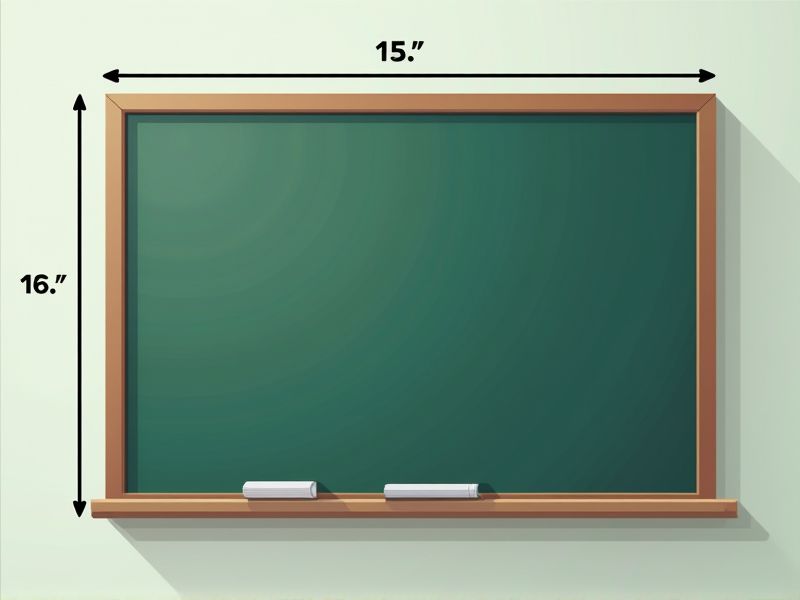
The standard dimensions of a classroom blackboard typically measure 4 feet in height and 8 feet in width. This size provides ample space for teachers to write notes, illustrate concepts, and engage with students during lessons. If you're setting up a learning space, consider this standard as it balances visibility from different parts of the room with practical installation requirements. However, smaller boards around 3 feet by 4 feet are also commonly used for limited spaces or individual use.
Height And Width
The standard dimensions for educational blackboards typically range around 48 inches in height and 96 inches in width, providing ample space for writing and visibility. This size accommodates various classroom layouts and ensures that students can easily read the content from different seating positions. When selecting a blackboard, consider the available wall space to maximize its height and width, enhancing the overall teaching environment. Your optimal choice can significantly impact classroom engagement and productivity.
Surface Material
The surface material of blackboards significantly impacts durability and usability, with high-quality surfaces often made from melamine, porcelain, or glass. Melamine boards are lightweight and budget-friendly, ideal for classrooms, while porcelain boards provide a robust, stain-resistant option renowned for longevity--lasting up to 50 years. Glass blackboards, although more expensive, offer a sleek finish and are easy to clean, making them highly desirable in modern environments. Choosing the right surface material can enhance your teaching experience and ensure sustained performance throughout its lifespan.
Frame Material
When selecting a blackboard, it's essential to consider the frame material, as it significantly impacts durability and aesthetics. Common frame materials include wood, metal, and plastic, each offering unique benefits; for instance, wooden frames provide a classic look while metal frames are known for their sturdiness. You should also note that blackboards with aluminum frames are lightweight, making them easier to install and relocate, whereas solid wood frames enhance stability and can last for decades. In terms of cost, metal frames often fall between $50 to $150, while premium wooden frames can range from $150 to $300, ensuring you choose the option that best fits your budget and design preferences.
Mounting Options
The standard for blackboard mounting options includes various configurations to accommodate different classroom environments. Wall-mounted systems are popular, utilizing durable brackets to ensure stability and support. Freestanding models provide flexibility, allowing easy repositioning and accessibility with floor space optimization in mind. You should consider the ideal height and installation type, as they can significantly impact visibility and user experience.
Depth And Thickness
The standard dimensions of a blackboard typically range from 4 to 12 feet in width, with a height varying from 3 to 5 feet, catering to various classroom environments. When assessing the depth and thickness, most blackboards boast a thickness of 1 inch, providing durability and stability. The surface material, often made of melamine or porcelain, affects the blackboard's finish, with high-quality options ensuring minimal ghosting and improved erasability. Selecting the right blackboard can transform your learning space, enhancing visibility and engagement for students.
Erasability Power
The Erasability Power of blackboards significantly influences their usability in educational settings and professional environments. A quality blackboard allows for over 1,000 clean erasures without ghosting or residue, ensuring clarity for repeated use. This durability not only enhances learning experiences but also reduces the need for frequent replacements, promoting cost-effectiveness. Investing in high-standard blackboards can greatly improve your presentations and teaching methodologies.
Color Variants
Blackboard offers an extensive range of color variants, allowing customization to suit diverse learning and professional environments. Available colors include classic green, elegant black, and vibrant blue, each designed to enhance visibility and reduce glare in various lighting conditions. The standard size of a blackboard typically measures 4 feet by 6 feet, providing ample space for notes and illustrations. You can elevate classroom engagement by choosing a color variant that complements your teaching style and enhances overall aesthetics.
Corner Design
The blackboard's corner design enhances usability by providing a smooth, rounded edge that minimizes the risk of injury while maintaining a sleek appearance. This thoughtful design feature can significantly reduce wear and tear on the board, ensuring durability for prolonged use in educational or professional environments. With a sturdy construction that typically measures 48 x 36 inches, your blackboard can accommodate a variety of writing tools and facilitate collaborative brainstorming sessions. Opting for this design not only improves safety but also contributes to a more aesthetically pleasing and organized workspace.
Magnetic Capability
The blackboard's magnetic capability is a significant feature, allowing its surface to securely hold magnets, creating an organized and interactive display for educational settings. With a typical thickness of 0.5 inches and dimensions ranging from 2x3 feet to 4x8 feet, these blackboards cater to various classroom layouts and needs. This magnetic property enhances functionality as it enables teachers to attach important materials, such as notes and visual aids, directly to the board. By incorporating this feature, you can create a more engaging and dynamic learning environment for students.
Modular Options
Blackboard's focus on modular options enhances educational flexibility and personalization for both educators and students. With over 700,000 users worldwide, it enables the creation of customizable course structures that adapt to various learning styles and objectives. The modular approach allows instructors to integrate multimedia resources, interactive assessments, and collaborative tools, fostering a more engaging learning environment. By leveraging analytics, teachers can monitor progress and make data-informed decisions to improve student outcomes effectively.
